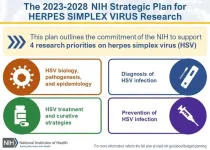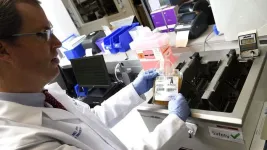(Press-News.org) Life on a faraway planet — if it’s out there — might not look anything like life on Earth. But there are only so many chemical ingredients in the universe’s pantry, and only so many ways to mix them. A team led by scientists at the University of Wisconsin–Madison has exploited those limitations to write a cookbook of hundreds of chemical recipes with the potential to give rise to life.
Their ingredient list could focus the search for life elsewhere in the universe by pointing out the most likely conditions — planetary versions of mixing techniques, oven temperatures and baking times — for the recipes to come together.
The process of progressing from basic chemical ingredients to the complex cycles of cell metabolism and reproduction that define life, the researchers say, requires not only a simple beginning but also repetition.
“The origin of life really is a something-from-nothing process,” says Betül Kaçar, a NASA-supported astrobiologist and UW–Madison professor of bacteriology. “But that something can’t happen just once. Life comes down to chemistry and conditions that can generate a self-reproducing pattern of reactions.”
Chemical reactions that produce molecules that encourage the same reaction to happen again and again are called autocatalytic reactions. In a new study published Sept. 18 in the Journal of the American Chemical Society, Zhen Peng, a postdoctoral researcher in the Kaçar laboratory, and collaborators compiled 270 combinations of molecules — involving atoms from all groups and series across the periodic table — with the potential for sustained autocatalysis.
“It was thought that these sorts of reactions are very rare,” says Kaçar. “We are showing that it's actually far from rare. You just need to look in the right place.”
The researchers focused their search on what are called comproportionation reactions. In these reactions, two compounds that include the same element with different numbers of electrons, or reactive states, combine to create a new compound in which the element is in the middle of the starting reactive states.
To be autocatalytic, the outcome of the reaction also needs to provide starting materials for the reaction to occur again, so the output becomes a new input says Zach Adam, a co-author of the study and a UW–Madison geoscientist studying the origins of life on Earth. Comproportionation reactions result in multiple copies of some of the molecules involved, providing materials for the next steps in autocatalysis.
“If those conditions are right, you can start with relatively few of those outputs,” Adam says. “Every time you take a turn of the cycle you spit out at least one extra output which speeds up the reaction and makes it happen even faster.”
Autocatalysis is like a growing population of rabbits. Pairs of rabbits come together, produce litters of new rabbits, and then the new rabbits grow up to pair off themselves and make even more rabbits. It doesn’t take many rabbits to soon have many more rabbits.
Looking for floppy ears and fuzzy tails out in the universe, however, probably isn’t a winning strategy. Instead, Kaçar hopes chemists will pull ideas from the new study’s recipe list and test them out in pots and pans simulating extraterrestrial kitchens.
“We will never definitively know what exactly happened on this planet to generate life. We don't have a time machine,” Kaçar says. “But, in a test tube, we can create multiple planetary conditions to understand how the dynamics to sustain life can evolve in the first place.”
Kaçar leads a NASA-supported consortium called MUSE, for Metal Utilization & Selection Across Eons. Her lab will focus on reactions including the elements molybdenum and iron, and she is excited to see what others cook up from the most exotic and unusual parts of the new recipe book.
“Carl Sagan said if you want to bake a pie from scratch, first you must create the universe,” Kaçar says. “I think if we want to understand the universe, first we must bake a few pies.”
This research was funded in part by grants from NASA Astrobiology Program (80NSSC22K0546), the John Templeton Foundation (62578 and 61926), the Research Corporation for Science Advancement (28788) and the Australian Research Council (DP210102133 and FT220100757).
END
New recipes for origin of life may point way to distant, inhabited planets
A team led by scientists at UW–Madison has exploited those limitations of chemical combinations to write a cookbook with hundreds of recipes that have the potential to give rise to life
2023-09-19
ELSE PRESS RELEASES FROM THIS DATE:
STUDY: Cancer misinformation on TikTok could be harmful to women’s health
2023-09-19
Millions of women are turning to the social media platform TikTok for health advice related to gynecologic cancers, but the majority of that information is misleading or dramatically inaccurate, according to a new study published by The Ohio State University Comprehensive Cancer Center – Arthur G. James Cancer Hospital and Richard J. Solove Research Institute in the journal Gynecologic Oncology.
Senior study author Laura Chambers, DO, says this highlights the power of social media to feed misinformation that could be ...
The latest in science and medical advancement in otolaryngology-head and neck surgery to be presented at AAO-HNSF Annual Meeting
2023-09-19
Alexandria, Virginia — The latest research and advances in otolaryngology-head and neck surgery will be presented in Nashville, Tennessee, during the AAO-HNSF 2023 Annual Meeting & OTO Experience, September 30 – October 4. From among the hundreds of research presentations submitted for the 2023 Annual Meeting, the Annual Meeting Program Committee (AMPC), comprised of physician members, selected 16 Scientific Oral Presentations as the Best of Orals, as well as an additional 40 Late-Breaking abstract submissions that were added to the Scientific Oral Presentation program to offer the latest and most ...
$7 million in new grants propel Tufts Lyme research to next level
2023-09-19
Researchers at the Tufts Lyme Disease Initiative recently received grants totaling more than $7 million to build on an already impressive array of discoveries that Tufts’ teams have made to combat tick-borne diseases.
While Lyme disease can often be successfully treated with antibiotics, 10-20% of patients experience persistent fatigue, joint pain, and mental impairments that last months or years. For some, it is never clear whether symptoms signal persistent infection, reinfection, or malfunction by the body’s immune system.
Researchers ...
Leading the way in global STI research
2023-09-19
Researchers in the University of Delaware College of Health Sciences Department of Medical and Molecular Sciences are playing a pivotal role on the global health stage as they investigate the most common sexually transmitted infection (STI) in the world.
Centers for Disease Control statistics show that 79 million Americans have human papillomavirus (HPV). With 14 million new infections each year, 80% of women will get at least one type of HPV at some point in their lifetime, according to the Office on Women’s ...
NIH releases strategic plan for research on herpes simplex virus 1 and 2
2023-09-19
WHAT:
In response to the persistent health challenges of herpes simplex virus 1 (HSV-1) and HSV-2, today the National Institutes of Health released the Strategic Plan for Herpes Simplex Virus Research. An NIH-wide HSV Working Group developed the plan, informed by feedback from more than 100 representatives of the research and advocacy communities and interested public stakeholders. The plan outlines an HSV research framework with four strategic priorities: improving fundamental knowledge of HSV biology, pathogenesis, and epidemiology; accelerating research to improve HSV diagnosis; improving strategies to treat HSV while seeking a curative therapeutic; and, advancing research ...
Early convalescent plasma use — helpful in avoiding severe COVID — also may lower long COVID risk
2023-09-19
Findings from a nationwide, multicenter study led by Johns Hopkins Medicine and the Johns Hopkins Bloomberg School of Public Health suggest that patients with COVID-19 have less chance of developing post-COVID conditions — commonly known as long COVID — if they receive early treatment with plasma from convalescent (recovered) COVID patients that contain antibodies against SARS-CoV-2, the virus that causes COVID-19.
The new research, first posted online today in mBio, a journal from the American Society for Microbiology, is a follow-up investigation to the 2021 clinical trial that showed convalescent plasma ...
Machine learning analysis of research citations highlights importance of federal funding for basic scientific research
2023-09-19
Biomedical research aimed at improving human health is particularly reliant on publicly funded basic science, according to a new analysis boosted by artificial intelligence.
“What we found is that even though research funded by the National Institutes of Health makes up 10% of published scientific literature, those published papers account for about 30% of the substantive research — the important contributions supporting even more new scientific findings — cited by further clinical research ...
Fast-track strain engineering for speedy biomanufacturing
2023-09-19
Using engineered microbes as microscopic factories has given the world steady sources of life-saving drugs, revolutionized the food industry, and allowed us to make sustainable versions of valuable chemicals previously made from petroleum.
But behind each biomanufactured product on the market today is the investment of years of work and many millions of dollars in research and development funding. Berkeley Lab scientists want to help the burgeoning industry reach new heights by accelerating and streamlining the process of engineering microbes to produce important compounds with ...
Firearm violence exposure in Black and American Indian/Alaska Native communities linked to poorer health
2023-09-19
There is a widening health disparity among Black, American Indian and Alaska Native adults exposed to gun violence, according to Rutgers researchers who say these communities have more mental and physical health issues because they witness or are victimized at a higher rate.
In a new study published in Health Affairs Scholar, 3,015 Black and 527 American Indian/Alaska Native (AI/AN) adults residing in the United States were surveyed between April and May 2023.
Participants were asked whether they were threatened with a firearm, shot with a firearm, had a family or friend shot with a firearm, or witnessed or heard about a shooting. The results found that these ...
New evidence indicates vitiligo-associated autoimmunity may contribute to reduced morbidity and mortality risk
2023-09-19
Philadelphia, September 19, 2023 – According to a new study comparing patients with and without vitiligo in South Korea, patients with vitiligo were associated with a 25% decreased risk of mortality compared with controls. This suggests that vitiligo-associated autoimmunity may play a role in reducing morbidity and mortality. The results appear in the Journal of Investigative Dermatology, published by Elsevier.
Previous studies have documented a reduced risk of cancer in patients with vitiligo, however, there has been limited research on the relationship between vitiligo-associated autoimmunity and the risk of morbidity and mortality ...
LAST 30 PRESS RELEASES:
There are new antivirals being tested for herpesviruses. Scientists now know how they work
CDI scientist, colleagues author review of global burden of fungus Candida auris
How does stroke influence speech comprehension?
B cells transiently unlock their plasticity, risking lymphoma development
Advanced AI dodel predicts spoken language outcomes in deaf children after cochlear implants
Multimodal imaging-based cerebral blood flow prediction model development in simulated microgravity
Accelerated streaming subgraph matching framework is faster, more robust, and scalable
Gestational diabetes rose every year in the US since 2016
OHSU researchers find breast cancer drug boosts leukemia treatment
Fear and medical misinformation regarding risk of progression or recurrence among patients with breast cancer
Glucagonlike peptide-1 receptor agonists and asthma risk in adolescents with obesity
Reviving dormant immunity: Millimeter waves reprogram the immunosuppressive microenvironment to potentiate immunotherapy without obvious side effects
Safety decision-making for autonomous vehicles integrating passenger physiological states by fNIRS
Fires could emit more air pollution than previously estimated
A new way to map how cells choose their fate
Numbers in our sights affect how we perceive space
SIMJ announces global collaborative book project in commemoration of its 75th anniversary
Air pollution exposure and birth weight
Obstructive sleep apnea risk and mental health conditions among older adults
How talking slows eye movements behind the wheel
The Ceramic Society of Japan’s Oxoate Ceramics Research Association launches new international book project
Heart-brain connection: international study reveals the role of the vagus nerve in keeping the heart young
Researchers identify Rb1 as a predictive biomarker for a new therapeutic strategy in some breast cancers
Survey reveals ethical gaps slowing AI adoption in pediatric surgery
Stimulant ADHD medications work differently than thought
AI overestimates how smart people are, according to HSE economists
HSE researchers create genome-wide map of quadruplexes
Scientists boost cell "powerhouses" to burn more calories
Automatic label checking: The missing step in making reliable medical AI
Low daily alcohol intake linked to 50% heightened mouth cancer risk in India
[Press-News.org] New recipes for origin of life may point way to distant, inhabited planetsA team led by scientists at UW–Madison has exploited those limitations of chemical combinations to write a cookbook with hundreds of recipes that have the potential to give rise to life







